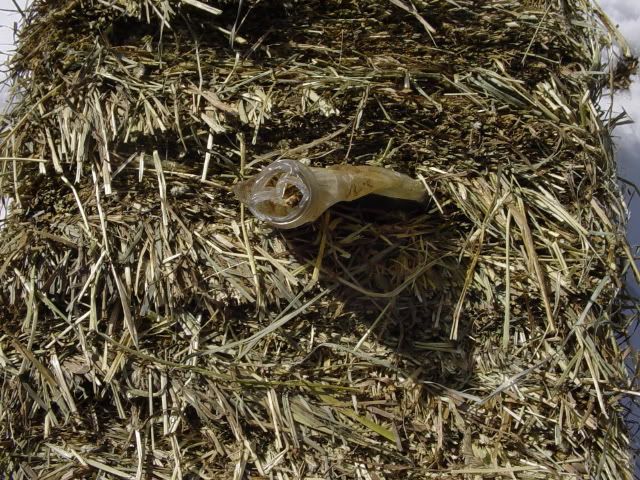 Around here, eastern NY, it seemed that hay, alfalfa etc. was a big part of agriculture. I can recall so many fields that are now housing developments. Everyone had their preference on how they would do it, but it was always predicated on the the equipment functioning and the weather + the help available. I don't think that has changed much, obviously resources for weather prediction have increased, but with the amount of rain and or hot humid tropical type weather it's still difficult to get good green hay dried and baled around here. I recall ( like was mentioned ) that many people would bale after it was topped out and tanning up a little, early July and later, usually one cutting, now that has changed, especially with the horse industry demands. We have up to 40 horses sometimes at our place and some of the crap that is out there is amazing, like what is in the photo above, a plastic bottle, we got the shaft on a few hundred bales and the seller immediately replaced the lot. All kinds of garbage in it, besides being tan and stalky, what a mess in the stalls, screws up the compost manure, too much carbon etc., so much better whe they eat it up, you have to feed 2-3x as much just to get the same effect. I know that to cater to horse industry, they like it green, un-rained on, less stalky, consistent without weeds, and some people can really be a pain about it, not knowing what goes into baling hay. We really try to be real about it, and some of the locals just show up with a few bales to try or look at, also some of the best we can find, it's good to try and work together, neither side the fence is easy to work on the way I see it, we're both in the same boat. One guy we bought from does nothing with his fields, bales them tight and heavy, out of 200 bales in one load last year, I found 26 soaked bales, ( could have burned the barn down ) his theory is the other dry ones will absorb the moisture from wet ones in his mow. I've loaded thousands out of his place, some are like bricks and have lots of weeds and crap in there. Horses pick through it and make a mess, takes longer to clean a stall and takes longer to compost. The farmer who plants the place where I live, keeps the fields up, not a lot of weeds and garbage, does a nice job of drying ( when the weather permits) and bales them a little looser, I buy all I can get and he ships it 30 miles, I'll be trucking some myself in June. His 2nd and later cuts are really nice, some alfalfa, quite a bit of timothy, I've seen some recent fields that he planted, looked like orchard grass or similar and it was like a thick green carpet, no weeds at all, it's too bad the customer who was also a friend of ours for many years passed on last year, the fields were just planted and let go last year, I'd love to get some off those fields, it grows well around here, especially if done right, was over 60 acres worth. We have an appreciation for what it takes to bale up the small squares, having done it for so many years ourselves, and really try not to pester any sellers like some do. We look at it closely, as long as there is no mold, even if rained on a little and tanned up some, sometimes it has to do, our neighbor the farmer had some good stuff down and rained on a little, he turned it after and it dried, was still good hay, better than a lot I've seen. I see some of the best hay in the area, go for $8.00/bale at the feed supply place by the racetrack, if properly done, a lot of these people will pay top dollar. The horse industry does not seem to be getting smaller, but the producers of hay still have the same headaches, makes you wonder what it will be like in the years ahead. I'm amazed at how little the price has gone up, the headaches are still there, equipment, weather, just handling squares, real hard sometimes to find any help today. Kind off the subject a little, but I've always enjoyed the smell of fresh hay, just hated being up in the loft/mow covered in sweat and chaff. We had 2 huge barns here years ago and myself and the neighbor/farmer who used to fill it with hay, besides his own place, were commenting on how large they really were, there used to be a lot of barns arond here like them, same with the fields, don't see the same production anymore for over 20-30 years give or take, that has certainly changed.
|





